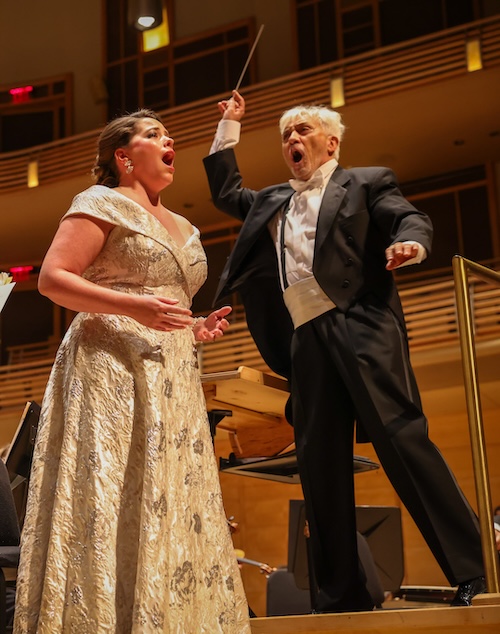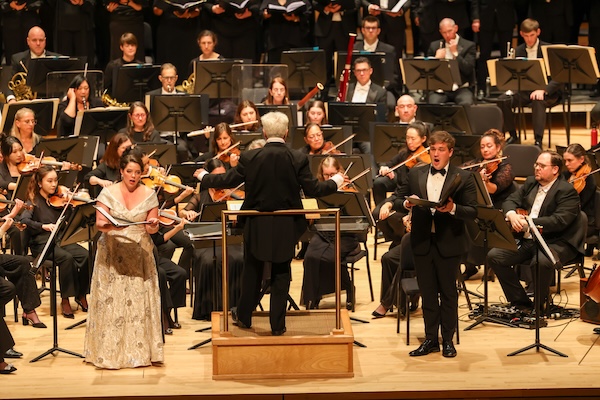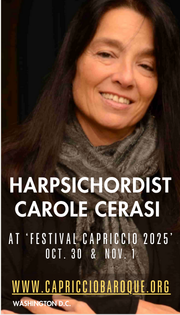A musical tribute to Mother Teresa ranges widely at Strathmore

Soprano Catherine Wethington with Dante Anzolini conducting members of the Baltimore Symphony Orchestra in a tribute to Mother Teresa Saturday night at the Music Center at Strathmore. Photo: Jim Saah
Mother Teresa is known everywhere for creating the Missionaries of Charity, identified by their white habits with blue borders, to minister to the desperately poor in Calcutta.
To honor the 75th anniversary of the order this year, as well as the 10th anniversary of the sanctification of its founder next year, a production company presented a concert of mostly sacred music Saturday night in the Music Center at Strathmore.
The musical talent assembled on stage for this performance distinguished itself, even if the programming choices proved uneven. Opening with Gabriel Fauré’s Requiem Mass showed off the vocal strength of the approximately forty-voice Tribute Chorale, assembled for this performance and prepared by Joseph Holt. Many of the singers are familiar to local audiences from their regular participation in operatic ensembles in the area.
While a canonized saint should not require a Requiem Mass, the program positioned the piece convincingly in recognition of Mother Teresa’s ministry to the dying. The men of the chorus, in particular, produced a robust and unified tone in their chant-like lines. The choir, with men behind women (both in single rows), blended admirably at all dynamics, handling the unaccompanied stretches with clean intonation.
The guiding light behind the concert, soprano Catherine Wethington, gave the solo line of the “Pie Jesu” movement a limpid clarity, never strained but filling the auditorium. Baritone Sean Michael Plumb added prophetic urgency in his solos, especially in the thundering lines of the “Libera Me.” That movement, the only reference to the Last Judgment that Fauré allowed in his careful textual selection from the Latin Requiem Mass, melted away at the angelic arpeggiation of the harp in the closing movement, “In Paradisum.”
The program’s second half intended to trace Mother Teresa’s life trajectory, from her native Albania, to Ireland where she took up the religious life of a nun, to India where she founded her new order. Wethington had a greater chance to showcase the power and flexibility of her voice, beginning with the aria “Ich folge dir gleichfalls” from Bach’s St. John Passion. Accompanied only by a single flute, cello, and the portative organ, her high G sounded with crystalline intonation.

Photo: Jim Saah
Representing Albania was the “Vallia me daire” movement from Thoma Gaqi’s Valle Simfonika. A sort of folk-tinged homage to Ravel’s Bolero, but with a tambourine marking the beat, the repetitive piece grew in a long crescendo and eventual acceleration.
Similarly meditative was the evening’s centerpiece, Genc Tukiçi’s Hymn for Mother Teresa, composed for Mother Teresa’s 2003 beatification in Vatican City. Tukiçi set a simple strophic hymn by Lorenc Antoni, Mother Teresa’s cousin, with words drawn from a poem in Albanian that the saint herself wrote about her departure for India when she was 18 years old.
Beginning with just the piano and two solo violins, the piece’s sweet minor-mode tune proved quite pleasing. In response to Wethington’s solo verses, the choir took up the melody with full orchestra providing a sonic backdrop for some very high notes added by the soprano. The texture returned to the opening trio, giving the sense of a voyage coming full circle.
From the British Isles were two secular selections, beginning with an arrangement of the tune “Down by the Salley Gardens.” An odd choice to honor a nun with pieces about lovers’ meeting, but Wethington sang it and “I dreamt I dwelt in marble halls,” from Irish composer Michael Balfe’s The Bohemian Girl with a gleaming vocal tone. Given the extended length of the second half, however, both selections could have been omitted.
Plumb returned for solid renditions of both “The Call” from Vaughan Williams’ Five Mystical Songs and “Simple Song,” which Leonard Bernstein incorporated into the otherwise chaotic jumble of his Mass. Schmaltz abounded in Vladimir Vavilov’s Ave Maria, a reworking of a tune that has since been attributed to Giulio Caccini.
For India, the program turned to a meaty Wagnerian interlude from Act III of Holst’s opera Sita, completed in 1906 but premiered only last year in Saarbrücken. Based on the Hindu epic Ramayana, if the opera is half as engaging as this orchestral excerpt, it should be worth hearing someday. Another instrumental selection, Missy Mazzoli’s These Worlds in Us, while well constructed again seemed ancillary to the program’s aims.
Members of the Baltimore Symphony Orchestra, minus a number of principals, played with polish and a sense of balance. Most of the musical drawbacks came from the conducting of Dante Anzolini, whose unclear beat seemed to confuse the coordination of voices and instruments. Similar issues plagued Anzolini’s appearance a decade ago, leading Washington National Opera’s staging of Philip Glass’s Appomattox.
Anzolini’s connection to Philip Glass seemed to put the closing selection, the “Paradise” movement from Glass’s Fifth Symphony on a more solid footing. With parts for soprano, baritone, and choir, it served aptly as a finale, although the abrupt ending perhaps went against that purpose.







